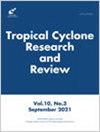从脆弱性到恢复力:解决菲律宾经常性山洪暴发的原因、影响和解决方案
IF 4.1
4区 地球科学
Q3 METEOROLOGY & ATMOSPHERIC SCIENCES
引用次数: 0
摘要
菲律宾是最容易发生灾害的国家之一。它的岛屿经常遭受洪水、台风、山体滑坡、地震、火山爆发和干旱的袭击,因为它们位于主要的构造板块和台风带。这个国家拥有海洋、河流、湖泊和溪流,但天气事件会释放大量的水,造成洪水。本研究探讨菲律宾山洪暴发及其来源、影响和解决方案。它侧重于主要的洪水,包括由台风和季风引起的洪水,以及易受影响的地区和东盟的预防方法。采用描述性-评估性研究设计,本研究与Ary的概念一致,即描述性研究旨在捕捉事件的当前状态。它需要从可靠的、相关的来源中挖掘数据,以告知研究结果。分析显示,反复发生的山洪对菲律宾所有地区构成相当大的风险,其中三区特别容易受到影响。超级台风“尤兰达”引发的灾难性洪水是菲律宾2010年至2020年间最严重的洪水事件。然而,季风引发的洪水也在很大程度上导致了每年的洪水,特别是在高度城市化和沿海地区。应优先关注吕宋岛北部,特别是ⅰ、ⅲ、ⅳ- a、ⅳ- b和中非共和国,这些地区山洪暴发的频率很高。实施可操作的洪水风险信息和强大的洪水预警系统,加强排水基础设施,为防洪举措分配预算,促进植树,以及采用柬埔寨的HYDRA洪水方法,这些都是为菲律宾洪水易发地区量身定制的可行防洪措施。本文章由计算机程序翻译,如有差异,请以英文原文为准。
From vulnerability to resilience: Addressing the causes, impacts, and solutions for recurrent flash floods in the Philippines
The Philippines is among the most disaster-prone nations. Its islands are frequently hit by floods, typhoons, landslides, earthquakes, volcanic eruptions, and droughts due to their location along major tectonic plates and in a typhoon belt .The country is blessed with oceans, rivers, lakes, and streams, but weather events can release massive amounts of water, causing flooding. This study investigates Philippine flash floods, their sources, effects, and solutions. It focuses on major floods, including those caused by both typhoons and monsoons, as well as susceptible locations and ASEAN prevention methods.
Employing a descriptive-evaluative research design, this study aligns with Ary's notion that descriptive research seeks to capture the current state of affairs. It entails data mining from reliable, pertinent sources to inform the study's outcomes. Analysis reveals that recurrent flash floods pose a considerable risk across all Philippine regions, with Region III standing out as particularly susceptible. The catastrophic flooding induced by Super Typhoon Yolanda marked the most severe flooding event in the Philippines between 2010 and 2020. However, monsoon-induced floods also significantly contributed to annual flooding, particularly in highly urbanized and coastal areas.
Attention and resources should be prioritized for Northern Luzon, notably Regions I, III, IV-A, IV-B, and CAR, which exhibit a high frequency of flash flood recurrences. Implementing actionable flood risk information and robust flood warning systems, reinforcing drainage infrastructure, allocating budgets for flood prevention initiatives, promoting tree planting, and adopting Cambodia's HYDRA Floods approach represent viable flood prevention measures tailored for the Philippines' flood-prone regions.
求助全文
通过发布文献求助,成功后即可免费获取论文全文。
去求助
来源期刊

Tropical Cyclone Research and Review
METEOROLOGY & ATMOSPHERIC SCIENCES-
CiteScore
4.60
自引率
3.40%
发文量
184
审稿时长
30 weeks
期刊介绍:
Tropical Cyclone Research and Review is an international journal focusing on tropical cyclone monitoring, forecasting, and research as well as associated hydrological effects and disaster risk reduction. This journal is edited and published by the ESCAP/WMO Typhoon Committee (TC) and the Shanghai Typhoon Institute of the China Meteorology Administration (STI/CMA). Contributions from all tropical cyclone basins are welcome.
Scope of the journal includes:
• Reviews of tropical cyclones exhibiting unusual characteristics or behavior or resulting in disastrous impacts on Typhoon Committee Members and other regional WMO bodies
• Advances in applied and basic tropical cyclone research or technology to improve tropical cyclone forecasts and warnings
• Basic theoretical studies of tropical cyclones
• Event reports, compelling images, and topic review reports of tropical cyclones
• Impacts, risk assessments, and risk management techniques related to tropical cyclones
 求助内容:
求助内容: 应助结果提醒方式:
应助结果提醒方式:


